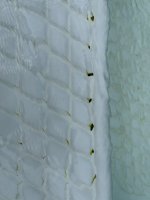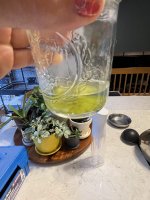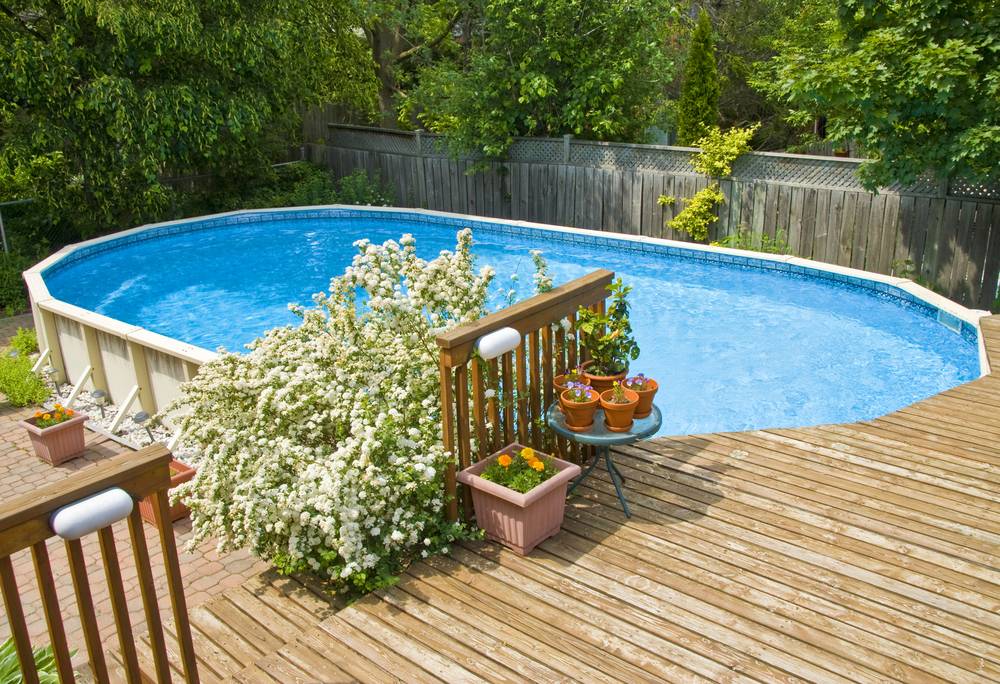First time poster - I apologize in advance for the lengthy post but wanted to give sufficient detail.
Stats:
20 x 40 inground vinyl pool we moved into last year
Very old equipment - 24” sand filter, single speed pump (runs 24/7), Hayward heater
Our plan is to get a new filter and pump at start of next season so we need to limp along with what we have.
Fighting high pH (gets to 8.0+ every few days and I treat with dry acid)
CYA 50
Use liquid chlorine (12.5%) - between a half gallon and full daily. We only shock when indicated - not on a weekly schedule.
Free Chlorine stays between 5-7
Zero Combined Chlorine
Since a huge storm passed through over a month ago, we’ve been fighting a green powder in our pool. I don’t believe it’s algae anymore since our FC levels have been consistently between 5-7. Left to it’s own devices, the water does become a greenish tint, although still easy to see through. The powder seems to accumulate near the jets (photo of it in the stair crevices below). We have been brushing and backwashing. We use the robot vac very 2-3 days and it picks almost all of it up (see photo of what washed off the filters into a mason jar).
I did shock with Cal Hypo and saw it clear up for a day or so. The pool store also convinced me to use a clarifier - we have no idea how old our sand is and they suggested the clarifier might help the particles get trapped. It did help for a few days.
I did an overnight chlorine loss test and we only lost 0.3 so it doesn’t seem to point to an algae. Also, I collected some pool water in a mason jar and it’s stayed completely clear for over 24 hours (not sure that means anything…)
Edited to add: we are in IL and back up to an extremely large preserve with wildflowers and prairie. That leads me to think pollen could be what I’m dealing with but don’t want to assume that and have it actually be an algae. We close in 3-4 weeks so I need to get this resolved STAT.
Any ideas? The only thing I can’t keep under control is our pH - could that be a contributing cause? Or is it likely a crapped out sand filter? Or am I totally off base and it is algae?
Thanks for your help
Stats:
20 x 40 inground vinyl pool we moved into last year
Very old equipment - 24” sand filter, single speed pump (runs 24/7), Hayward heater
Our plan is to get a new filter and pump at start of next season so we need to limp along with what we have.
Fighting high pH (gets to 8.0+ every few days and I treat with dry acid)
CYA 50
Use liquid chlorine (12.5%) - between a half gallon and full daily. We only shock when indicated - not on a weekly schedule.
Free Chlorine stays between 5-7
Zero Combined Chlorine
Since a huge storm passed through over a month ago, we’ve been fighting a green powder in our pool. I don’t believe it’s algae anymore since our FC levels have been consistently between 5-7. Left to it’s own devices, the water does become a greenish tint, although still easy to see through. The powder seems to accumulate near the jets (photo of it in the stair crevices below). We have been brushing and backwashing. We use the robot vac very 2-3 days and it picks almost all of it up (see photo of what washed off the filters into a mason jar).
I did shock with Cal Hypo and saw it clear up for a day or so. The pool store also convinced me to use a clarifier - we have no idea how old our sand is and they suggested the clarifier might help the particles get trapped. It did help for a few days.
I did an overnight chlorine loss test and we only lost 0.3 so it doesn’t seem to point to an algae. Also, I collected some pool water in a mason jar and it’s stayed completely clear for over 24 hours (not sure that means anything…)
Edited to add: we are in IL and back up to an extremely large preserve with wildflowers and prairie. That leads me to think pollen could be what I’m dealing with but don’t want to assume that and have it actually be an algae. We close in 3-4 weeks so I need to get this resolved STAT.
Any ideas? The only thing I can’t keep under control is our pH - could that be a contributing cause? Or is it likely a crapped out sand filter? Or am I totally off base and it is algae?
Thanks for your help





